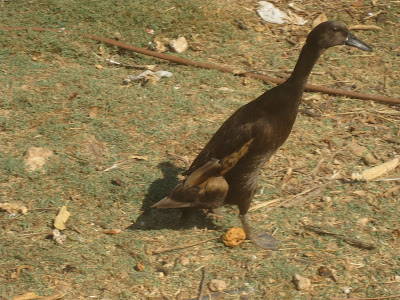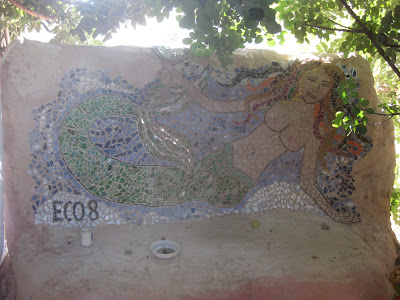My five months in Israel have been jam-packed with Jewish
Holiday awesomeness. This is the first time I spent the High Holy Days in the
Holy Land. For Rosh Hashannah, I
stayed with my friend Matan’s family in Jerusalem. For Yom Kippur, I stayed with my instructor Rina’s family,
also in Jerusalem, and for Sukkot, we celebrated the harvest together on the
farm and then commenced on a 3.5 day hike from the farm to the kotel in
Jerusalem. Most recently, we had a Chanukah break where I traveled to Eilat and
Petra, and then ended the holiday visiting friends in Jerusalem.
Rosh Hashannah:
I
was so excited to reunite with my friend Matan upon his return to Israel after
several months in the states, We spent the summer working on the camping staff
together at Ramah, after which he traveled around North America with
friends. His dad was nice enough
to pick me up from the farm on the way back from picking Matan up from the
airport, so I completely crashed his homecoming. Matan’s family has a lovely apartment in Jerusalem, right
near the Goldstein Youth Village, where I stayed five years ago on Ramah
Seminar. His family was so warm
and welcoming to me and I felt like one of the family right away. We arrived on Friday and Matan took me
out to Abu Gosh with ALL of his friends for hummus, limonana and
nargillah. It was pretty
overwhelming to hear all that Hebrew, but the food was delicious and it was
great to meet his friends. Shabbat
was spent relaxing at home with his family and going on walks around the nearby
parks, playing Frisbee, and meeting up with his friends. On Saturday night, we drove off to a
nearby spring to go camping and make poyke. Poyke is a slow-cooked stew in a large cast iron cauldron
set over a campfire. You basically
just throw whatever ingredients you have around into the pot and let it cook
forever. It was delicious.
Matan’s
whole family converged at his parent’s apartment for Rosh Hashannah. This
included Matan and his three older sisters, two brother-in-laws, and two young
nephews aged two months and one and a half years. I had such a great time
playing with the adorable babies.
Every meal also included other neighbors, friends, and more distant
relatives. Like in the states,
Rosh Hashannah is a very family-oriented holiday. The first day of Rosh
Hashannah I went to Matan’s mother’s orthodox synagogue. I enjoyed the service for its beautiful
singing. The shul was relatively
egalitarian compared to other orthodox shuls I have been to. The two sides of the mechitza were
equal in size and only separated by a sheer cloth so you could see the service
pretty clearly. In the evening we had a traditional Rosh Hashonnah Seder. There are seven species of Israel that
you must include on the Rosh Hashannah table; wheat, barley, grapes, figs,
pemegranates, dates, and olives, as well as other traditional Rosh Hashannah foods, including
apples and honey, a fish head, carrots, nuts, black-eyed peas, fenugreek,
cabbage, and beets. Each food was paired with a blessing. For example, for the pomegranate, you
wish for the next year to be plentiful with mitzvot, like the seeds of a
pomegranate. The dinner consisted of matzo ball soup, chopped liver, potato
kugel and loads of salad and veggie dishes. It was all very delicious. The
second day f Rosh Hashanah I went to Matan’s father, Ilan’s’s reform shul. When I walked in, I was immediately
welcomed and given a part opening the ark during the service. Ilan had a big
role leading several of the services and has a beautiful voice. I spent the
rest of the holiday hanging out with Matan’s family and friends. We went to the
stream in the Goldstein Youth Village for tashlich, a symbolic tossing of
breadcrumbs into the water as a release of sins. It was so fun walking around the campus and remembering all
the fun times I had on Ramah Seminar.
There were heaps of people there, and Matan’s family knew everyone. After tossing their sins, the family
stayed around chatting and sitting in the park. It seemed like a very
tight-knit community. After the holiday finished, I went out to downtown
Jerusalem and met up with a big group of friends from the Mishlachat at
camp. It was so great to see
everyone and a wonderful end to a very restful and beautiful holiday.
Yom Kippur:
For
Yom Kippur Lauren and I stayed in Jerusalem again, this time with the family of
my madricha, Rina. They lived in a
beautiful house with gardens and in mixed Arab-Israeli neighborhood called Abu
Tor. For services, we walked along
a park that lined former train tracks to their temple, Kol Hanishamah. The services were really nice, with
lots of singing. It was a huge
crowd, but everyone seemed to know each other. Part way through the service, Rina’s little sister, Avital,
insisted that we take a break and go on a quick walk outside. The streets of Jerusalem during Yom
Kippur are amazing! There isn’t a
single car in the road. Instead,
the streets are filled with people.
Children on bikes and scooters are the kings, speeding around without
fear in their little gangs. Adults
walk along on the side of the road, stopping every few minutes to chat with
neighbors and friends. Everyone is
out and about. We returned to the house in the
afternoon to nap from the fasting, and then in the evening, we went to an
interesting alternative service. The service took place in the natural history
museum gardens. A tent was set up, draped with so many dazzling, multicolored
tapestries. Everyone was gathered
in a circle under the tapestries, clapping and singing with little kids on
their shoulders. There was so much
spirit and energy. Everyone
brought some food to share with the community for breaking the fast. It was so
nice to spend both high holy days with real Israeli families. I felt so well taken care of and really
got into the spirit of the holidays.
Sukkot:
For
Sukkot, we started the celebration with a feast on the farm. My friend Nomi came to visit and we
spent the day preparing for the meal.
Our group built a huge sukkah, covered with palm fronds and decorated
with bouquets of flowers, huge handmade candles, and strings of old cds we
found that glittered in the light.
We picked heaps of veggies in the fields and then cooked curried
lentils, coconut-vegetable rice, greek salad, corn salad, baked eggplant-tomato
salad, challah and bread, and completed the table with the seven species of
Israel. We invited the whole
community for dinner. After
dinner, we celebrated the full moon by building a massive bonfire. We danced around the fire to drums, guitar
and tambourines, singing every song we knew, and covered ourselves with face
paint. If was the first evening of
rain that we experienced in Israel- not hard rain- but it felt like a blessing
and we thought it was so exciting.
We
completed the Sukkot holiday by aliyah ha’regel. In the time of the temple, Jews all over would take the best
of their harvest with them and walk to the temple for the Sukkot
celebration. We brought back this
tradition for ourselves by picking some of our harvest and then hiking from our
farm, to the Western Wall in Jerusalem.
The hike was an amazing experience that really brought our group
together. We hiked long hours
through the day, up and down mountains and valleys, jumping in water holes, and
exploring old caves and ancient ruins.
At night, we camped under the stars, taking turns with “guard duty” and
cuddling up close when the nights grew cold. It was such a great feeling of accomplishment when we made
it to the kotel, said the shema and stuck our prayer notes into the Wall. I can only imagine how our ancient
ancestors must have felt when they made it to the temple after their own long
journeys. We made it to the Wall
just in time for the end of Sukkot and the start of Simchat Torah.
Chanukah:
Though
not a High Holy Day, we most recently experienced Chanukah in Israel. Chanukah is not as big of a deal in
Israel as it is in the States, but still fun the see. We got a week off from the farm for the holiday. I traveled to Eilat, Petra and Wadi Rum
for most of our break, making my own Chanukah candles by burning strips of
paper in the sand, but I finished off the holiday visiting my friend Nomi in
Jerusalem. Jerusalem during Chanukah is quite a sight. Every window has a Chanukah
menorah. Even the stores had them
glowing next to their cash registers.
There were huge electric ones at many street corners. Every restaurant and coffee shop sold
piles of sufganiyot- traditional Chanukah jelly doughnuts filled with every
flavor imaginable- from strawberry to pistachio to tiramisu. For Chanukah
Shabbat, Nomi and I went to the home of our friend Hannah’s family. It was a huge party, with over thirty
people from their family there and endless piles of food, candles, dreidels,
and singing of Chanukah songs- most of which I’ve never heard. It was great fun, but made me miss
Chanukah with my own family. We
walked the hour and a half back to Nomi’s apartment on Mount Scopus in the
evening, admiring the beautiful, cold city at night.
I can’t believe I only have a month left in Israel. It has been a whirlwind! I’m sorry for not updating my blog but
I will try to fit in as much as I can now that my time here is quickly coming
to an end and I have been reflecting on al I have felt and experienced here! I hope I will be able to experience
these beautiful holidays in Israel again one day.































